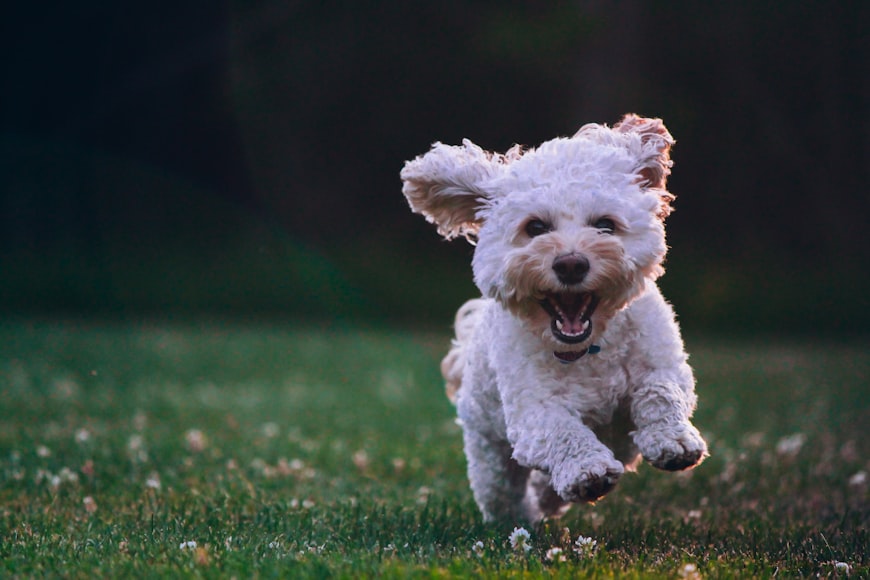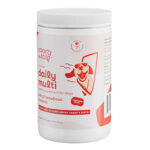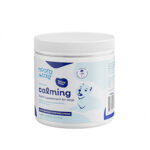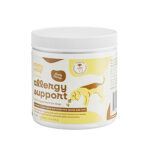Calming Your Furry Friend: Safe and Effective Solutions for Dog Anxiety During Fireworks

Fireworks can be a source of joy for humans, but for many dogs, they are a terrifying experience. The loud noises, bright flashes, and unpredictable nature of fireworks can trigger severe anxiety in dogs, leading to behaviors like trembling, hiding, excessive barking, or even attempts to escape. As a responsible pet owner, it’s essential to understand how to help your dog cope with this stress. Below, we explore safe and effective solutions to manage your dog’s fireworks anxiety.
1. Understanding Dog Anxiety During Fireworks
Dogs have heightened senses, particularly when it comes to hearing. The loud, sudden noises of fireworks can be overwhelming for them, as their ears are far more sensitive than ours. This can trigger a fight-or-flight response, causing panic and distress. Additionally, the unpredictability of fireworks—when and where they will go off—can exacerbate the anxiety.
Common signs of fireworks anxiety in dogs include:
– Pacing or restlessness
– Panting excessively
– Trembling or shaking
– Hiding in small spaces
– Destructive behavior, such as chewing or scratching
– Attempting to escape from the home or yard
Recognizing these signs is the first step in helping your dog feel safe and secure during fireworks displays.
2. Creating a Safe Space for Your Dog
One of the most effective ways to help your dog cope with fireworks anxiety is by creating a safe space where they can retreat. This space should be quiet, comfortable, and familiar to your dog. Here’s how to set it up:
- Choose a Quiet Room: Select a room in your home that is farthest from the noise of fireworks. Basements or interior rooms without windows are ideal.
- Add Comfort Items: Place your dog’s favorite bed, blankets, and toys in the space. Familiar scents can help them feel more secure.
- Use Soundproofing Techniques: Close windows, draw curtains, and consider using white noise machines or calming music to drown out the sound of fireworks.
- Stay Close: If your dog feels more comfortable with you nearby, spend time in the safe space with them. Your presence can be incredibly reassuring.
3. Behavioral Training and Desensitization
For long-term management of fireworks anxiety, behavioral training and desensitization can be highly effective. These techniques involve gradually exposing your dog to the sounds of fireworks in a controlled environment, helping them build tolerance over time.
- Start with Low Volume: Play recordings of fireworks at a very low volume while engaging your dog in a positive activity, such as playing or eating treats.
- Gradually Increase Volume: Over several weeks, slowly increase the volume of the recordings, ensuring your dog remains calm and relaxed.
- Reward Calm Behavior: Use positive reinforcement by rewarding your dog with treats, praise, or playtime when they remain calm during the training sessions.
- Practice Regularly: Consistency is key. Regular training sessions will help your dog associate the sound of fireworks with positive experiences.
4. Natural Remedies for Dog Anxiety
If your dog’s fireworks anxiety is mild to moderate, natural remedies can be a safe and effective option. These remedies are non-invasive and can help promote relaxation without the need for medication.
- Calming Supplements: Products containing L-theanine, melatonin, or chamomile can help reduce anxiety. Always consult your veterinarian before introducing any new supplements.
- Essential Oils: Certain essential oils, such as lavender and chamomile, have calming properties. Use a diffuser to disperse the scent in your dog’s safe space, but ensure the oils are pet-safe and diluted properly.
- Thundershirts: A Thundershirt is a snug-fitting garment that applies gentle pressure to your dog’s body, similar to a weighted blanket. This can help reduce anxiety by providing a sense of security.
- CBD Oil: CBD oil derived from hemp has gained popularity for its calming effects on dogs. It can help reduce anxiety without causing sedation. However, always choose high-quality, pet-specific products and consult your vet for proper dosage.
5. Prescription Medications for Severe Anxiety
For dogs with severe fireworks anxiety, prescription medications may be necessary. These medications should only be used under the guidance of a veterinarian and are typically reserved for extreme cases.
- Anti-Anxiety Medications: Drugs like alprazolam (Xanax) or diazepam (Valium) can help calm your dog during fireworks. These medications work quickly but should be used sparingly and only as directed by your vet.
- Sedatives: In some cases, sedatives may be prescribed to help your dog sleep through the fireworks. However, these should only be used as a last resort.
- Trazodone: This medication is commonly prescribed for situational anxiety, such as during fireworks or thunderstorms. It helps promote relaxation without causing excessive sedation.
6. Preparing for Fireworks Events
Proactive preparation can make a significant difference in how your dog handles fireworks. Here are some tips to help you and your furry friend get through the event:
- Exercise Your Dog: A tired dog is a calm dog. Take your dog for a long walk or engage in vigorous play before the fireworks begin. This can help reduce their overall anxiety levels.
- Feed Them Early: Feed your dog a few hours before the fireworks start. A full stomach can help them feel more relaxed.
- Stay Indoors: Keep your dog indoors during fireworks displays. Even if they are usually calm outside, the loud noises can cause them to panic and run away.
- Monitor Their Behavior: Keep a close eye on your dog during the fireworks. If they show signs of extreme distress, such as excessive drooling or attempts to escape, intervene immediately.
7. Alternative Therapies for Long-Term Relief
In addition to the above solutions, alternative therapies can provide long-term relief for dogs with chronic fireworks anxiety. These therapies focus on addressing the root cause of the anxiety and promoting overall well-being.
- Acupuncture: This ancient practice involves inserting thin needles into specific points on your dog’s body to promote relaxation and reduce anxiety.
- Massage Therapy: Gentle massage can help soothe your dog’s nerves and release tension. Focus on areas like the neck, shoulders, and back.
- Behavioral Therapy: Working with a certified animal behaviorist can help identify the underlying causes of your dog’s anxiety and develop a customized treatment plan.
By understanding your dog’s needs and implementing these strategies, you can help them feel safe and secure during fireworks displays. Remember, every dog is unique, so it may take some trial and error to find the best solution for your furry friend.
Introduction: Understanding the Impact of Fireworks on Dogs

Dogs are highly sensitive to loud noises, and fireworks are one of the most common triggers for canine anxiety. The sudden, unpredictable bursts of sound and bright flashes can cause extreme stress in dogs, leading to behaviors such as trembling, excessive barking, hiding, or even destructive actions. This anxiety stems from their heightened senses and instinctual response to perceived threats. Recognizing the signs of firework anxiety is the first step in helping your dog cope.
2. Why Fireworks Are Particularly Stressful for Dogs
Unlike humans, dogs cannot rationalize the source of loud noises like fireworks. Their acute hearing makes the sounds even more overwhelming, often causing a fight-or-flight response. Additionally, the unpredictability of fireworks—when and where they will occur—adds to the stress. This combination of sensory overload and lack of control can make firework season a traumatic experience for many dogs.
3. Immediate Solutions: Calming Products and Techniques
There are several calming products and techniques that can help alleviate your dog’s anxiety during fireworks:
- Thundershirts: These snug-fitting garments apply gentle pressure to your dog’s body, mimicking the feeling of being held, which can have a calming effect.
- Calming Supplements: Products containing ingredients like L-theanine, melatonin, or CBD oil can help reduce anxiety. Always consult your veterinarian before introducing any supplements.
- White Noise Machines: Playing soothing sounds or white noise can help mask the sound of fireworks.
- Distraction Techniques: Engage your dog with their favorite toys or treats to redirect their focus away from the noise.
4. Behavioral Training for Long-Term Relief
While immediate solutions can help in the short term, behavioral training is essential for long-term relief. Techniques such as desensitization and counter-conditioning can help your dog become less reactive to loud noises over time:
- Desensitization: Gradually expose your dog to recorded firework sounds at a low volume, increasing the volume slowly as they become more comfortable.
- Counter-Conditioning: Pair the sound of fireworks with positive experiences, such as treats or playtime, to create a new, positive association.
5. Creating a Safe Space for Your Dog
Providing a safe space where your dog can retreat during fireworks is crucial. This could be a quiet room, a crate, or a designated corner with their favorite bedding and toys. Make sure this space is easily accessible and free from loud noises. Adding familiar scents, such as a blanket with your scent, can also provide comfort.
6. The Role of Exercise and Routine
Maintaining a consistent routine and ensuring your dog gets plenty of exercise can help reduce overall anxiety levels. A tired dog is less likely to be as reactive to stress triggers. Take your dog for a long walk or engage in vigorous play before the fireworks begin to help them burn off excess energy.
7. When to Seek Professional Help
If your dog’s anxiety during fireworks is severe and none of the above methods provide relief, it may be time to consult a veterinarian or a certified animal behaviorist. They can assess your dog’s specific needs and recommend advanced treatments, such as prescription anti-anxiety medications or specialized therapy.
8. Preparing for Firework Events in Advance
Planning ahead can make a significant difference in how your dog copes with fireworks. Here are some steps to take:
- Check Local Schedules: Be aware of when and where fireworks will occur in your area.
- Create a Calm Environment: Close windows, draw curtains, and play calming music to minimize the impact of fireworks.
- Stay Home if Possible: Your presence can provide comfort and reassurance to your dog during stressful events.
9. The Importance of Patience and Consistency
Helping your dog overcome firework anxiety is a process that requires patience and consistency. Every dog is different, and what works for one may not work for another. Be prepared to try multiple strategies and adjust your approach as needed. Over time, with the right support, your dog can learn to cope better with loud noises.
10. Educating Others About Canine Anxiety
As a pet owner, you can play a role in raising awareness about the impact of fireworks on dogs. Share your experiences and tips with other dog owners, and advocate for quieter, pet-friendly alternatives to traditional fireworks. By working together, we can create a safer and more comfortable environment for our furry friends during celebratory events.
Natural Remedies to Soothe Your Dog’s Anxiety

1. Calming Herbs: Chamomile and Valerian Root
Chamomile: A Gentle Soother
Chamomile is a well-known herb used for its calming properties in both humans and animals. It contains compounds like apigenin, which binds to receptors in the brain, promoting relaxation and reducing anxiety. For dogs, chamomile can be administered in several forms, including chamomile tea, tinctures, or capsules.
Valerian Root: Nature’s Sedative
Valerian root is another powerful herb known for its sedative effects. It works by increasing levels of GABA (gamma-aminobutyric acid) in the brain, which helps calm the nervous system. This makes it particularly effective for dogs experiencing firework anxiety.
2. CBD Oil for Dogs: A Promising Solution
What is CBD Oil?
CBD (cannabidiol) is a non-psychoactive compound derived from the hemp plant. Unlike THC, it does not produce a “high” but has been shown to have calming and anti-inflammatory effects. Studies suggest that CBD interacts with the endocannabinoid system in dogs, helping to regulate mood, pain, and stress responses.
Benefits of CBD Oil for Firework Anxiety
- Reduces Anxiety: Research has shown that CBD can significantly lower anxiety levels in dogs exposed to stressful stimuli, such as loud noises.
- Anti-Inflammatory Properties: CBD may also help alleviate physical symptoms of stress, such as muscle tension or gastrointestinal discomfort.
- Non-Addictive: Unlike some pharmaceutical options, CBD is not habit-forming and has minimal side effects when used correctly.
Dosage Guidelines for CBD Oil
- General Dosage: The recommended dosage for CBD oil in dogs is 1-2 mg per 10 pounds of body weight. For example, a 30-pound dog would typically receive 3-6 mg of CBD.
- Administration: CBD oil can be administered directly into your dog’s mouth or mixed with their food. Start with the lowest effective dose and gradually increase if needed.
Safety Precautions
- Choose High-Quality Products: Look for CBD oil that is specifically formulated for pets and has been third-party tested for purity and potency.
- Avoid THC: Ensure the product contains less than 0.3% THC, as higher levels can be toxic to dogs.
- Consult Your Vet: Always discuss CBD use with your veterinarian, especially if your dog is on other medications or has underlying health conditions.
3. Additional Natural Remedies and Techniques
Adaptil: A Pheromone-Based Solution
Adaptil is a synthetic version of the dog-appeasing pheromone (DAP) that mother dogs produce to calm their puppies. It comes in various forms, including collars, diffusers, and sprays. Studies have shown that Adaptil can reduce anxiety-related behaviors in dogs, making it a useful tool during fireworks.
- How to Use Adaptil:
- Use a diffuser in the room where your dog spends most of their time. Plug it in at least a few days before the expected fireworks to allow the pheromones to build up in the environment.
- For on-the-go calming, consider an Adaptil collar or spray applied to your dog’s bedding or favorite resting spot.
Thundershirt: Pressure Therapy
The Thundershirt is a snug-fitting garment that applies gentle, constant pressure to your dog’s body. This pressure has a calming effect, similar to swaddling a baby. Many dog owners report significant improvements in their pet’s anxiety levels during fireworks when using a Thundershirt.
- How to Use a Thundershirt:
- Introduce the Thundershirt to your dog before the fireworks begin, allowing them to get used to the sensation.
- Ensure the fit is snug but not too tight, as this could cause discomfort.
Behavioral Training and Desensitization
While natural remedies can provide immediate relief, long-term solutions often involve behavioral training and desensitization.
4. Creating a Safe and Calming Environment
Soundproofing and White Noise
- Use white noise machines or fans to mask the sound of fireworks.
- Close windows and curtains to reduce both noise and visual stimuli.
Safe Spaces
- Create a designated safe space for your dog, such as a cozy crate or a quiet room with their favorite toys and bedding.
- Encourage your dog to retreat to this space during fireworks, but never force them to stay if they prefer to be near you.
Stay Calm and Reassuring
Dogs are highly attuned to their owners’ emotions. Remaining calm and providing gentle reassurance can help your dog feel more secure during fireworks.
By combining these natural remedies and techniques, you can help your dog navigate the stress of fireworks with greater ease and comfort. Always monitor your dog’s response to any new treatment and consult your veterinarian for personalized advice.
Behavioral Techniques to Help Your Dog Cope

Fireworks can be a source of immense stress for dogs, triggering anxiety and fear due to their loud, unpredictable noises. While some pet owners may consider medications or supplements, behavioral techniques can be highly effective in helping dogs cope with their fear. Below, we explore three key strategies: desensitization training, positive reinforcement, and creating a safe space, along with real-life success stories to inspire hope.
1. Desensitization Training: Reducing Fear of Loud Noises
Desensitization training is a gradual process that helps dogs become less sensitive to the sounds of fireworks. The goal is to expose your dog to recorded firework sounds at a low volume and gradually increase the intensity over time, ensuring they remain calm throughout the process.
How to Implement Desensitization Training:
- Start by playing firework sounds at a very low volume, barely audible to your dog. Pair this with positive experiences, such as treats, playtime, or cuddles.
- Gradually increase the volume over several days or weeks, always monitoring your dog’s reaction. If they show signs of stress, reduce the volume and proceed more slowly.
- Incorporate counter-conditioning by associating the sound of fireworks with something enjoyable, like their favorite toy or a high-value treat.
Why It Works:
Desensitization works by rewiring your dog’s brain to associate the sound of fireworks with positive experiences rather than fear. Over time, this reduces their anxiety response and helps them remain calm during real fireworks displays.
2. Positive Reinforcement: Building Confidence and Calmness
Positive reinforcement is a powerful tool for shaping your dog’s behavior and helping them feel more secure during stressful situations. By rewarding calm behavior, you can teach your dog that staying relaxed during fireworks is a good thing.
Key Steps for Positive Reinforcement:
- Observe your dog’s behavior during fireworks or similar loud noises. Look for moments when they remain calm, even if it’s just for a few seconds.
- Immediately reward calm behavior with treats, praise, or affection. This reinforces the idea that staying calm leads to positive outcomes.
- Avoid comforting your dog excessively if they show signs of fear, as this can inadvertently reinforce their anxious behavior. Instead, focus on rewarding moments of calmness.
The Science Behind It:
Positive reinforcement taps into your dog’s natural desire to seek rewards. By consistently rewarding calm behavior, you help your dog build confidence and reduce their reliance on fear-based responses.
3. Creating a Safe Space: A Refuge from the Noise
A safe space is a designated area where your dog can retreat during fireworks or other stressful events. This space should be quiet, comfortable, and filled with familiar items that provide a sense of security.
How to Create a Safe Space:
- Choose a quiet room or corner of your home, away from windows and external noise.
- Add soft bedding, your dog’s favorite toys, and an item with your scent, such as a blanket or piece of clothing.
- Use white noise machines or calming music to mask the sound of fireworks.
- Encourage your dog to use this space during non-stressful times so they associate it with comfort and safety.
Why It’s Effective:
A safe space provides your dog with a sense of control during unpredictable events. Knowing they have a secure place to retreat can significantly reduce their anxiety levels and help them feel more at ease.
Success Stories: Dogs Overcoming Firework Anxiety
Story 1: Max, the Terrified Terrier
Max, a 5-year-old terrier, would tremble and hide under the bed at the sound of fireworks. His owner started desensitization training by playing firework sounds at a low volume while giving Max his favorite treats. Over several weeks, Max began to associate the sounds with positive experiences. By the next fireworks season, Max was able to stay calm and even nap during the displays.
Story 2: Bella, the Anxious Labrador
Bella, a 3-year-old Labrador, would bark incessantly during fireworks. Her owner used positive reinforcement to reward moments of calmness, such as sitting quietly or lying down. Over time, Bella learned that staying calm earned her treats and praise. Now, she remains relaxed during fireworks and even seeks out her safe space when she hears loud noises.
Story 3: Charlie, the Fearful Chihuahua
Charlie, a 2-year-old Chihuahua, would panic and try to escape during fireworks. His owner created a safe space in a closet, complete with soft blankets, toys, and a white noise machine. Charlie quickly learned to retreat to this space during fireworks, where he felt secure and protected.
By combining desensitization training, positive reinforcement, and a safe space, you can help your dog overcome their fear of fireworks and build lasting confidence. These techniques not only address the immediate issue of firework anxiety but also strengthen the bond between you and your furry friend.
Over-the-Counter and Prescription Options

Fireworks are a common trigger for canine anxiety, as the loud noises, bright flashes, and unpredictable nature of these events can overwhelm a dog’s senses. Dogs have a heightened sense of hearing, making the loud bangs of fireworks particularly distressing. Symptoms of anxiety in dogs may include panting, trembling, pacing, hiding, excessive barking, or even destructive behavior. Recognizing these signs is the first step in addressing your dog’s discomfort and finding effective solutions.
2. Over-the-Counter Solutions for Firework Anxiety
For mild to moderate anxiety, over-the-counter (OTC) products can be a safe and effective way to help your dog cope with fireworks. These options are widely available and do not require a prescription, making them a convenient choice for many pet owners.
2.1 Calming Chews and Supplements
Calming chews are a popular OTC option for managing canine anxiety. These products often contain natural ingredients like L-theanine, melatonin, chamomile, or valerian root, which are known for their calming properties. For example, L-theanine promotes relaxation without causing drowsiness, while melatonin helps regulate sleep cycles and reduce stress.
It’s important to choose high-quality calming chews from reputable brands to ensure safety and efficacy. Always follow the dosage instructions provided on the packaging, and consult your vet if your dog has any pre-existing health conditions or is taking other medications.
2.2 Pheromone Diffusers and Sprays
Pheromone-based products, such as Adaptil, mimic the natural calming pheromones produced by mother dogs to comfort their puppies. These products come in various forms, including diffusers, sprays, and collars. A pheromone diffuser can be plugged into an outlet in the room where your dog spends most of their time, releasing calming scents that help reduce anxiety.
Pheromone sprays can be applied to your dog’s bedding or a bandana worn around their neck. These products are non-invasive and have no known side effects, making them a great option for dogs with mild anxiety.
2.3 Thundershirts and Compression Wraps
Thundershirts or compression wraps are another OTC solution that can help alleviate anxiety during fireworks. These garments apply gentle, constant pressure to your dog’s body, similar to swaddling a baby. This pressure has a calming effect on the nervous system, reducing stress and promoting relaxation.
Thundershirts are easy to use and can be combined with other anxiety-relief methods for enhanced effectiveness. However, they may not work for all dogs, so it’s important to monitor your pet’s response.
3. When to Consider Prescription Medications
While OTC products can be effective for mild anxiety, some dogs may require stronger interventions, especially if their anxiety is severe or if they have a history of panic attacks during fireworks. In such cases, consulting your veterinarian for prescription medications is recommended.
3.1 Sedatives and Anti-Anxiety Drugs
Veterinarians may prescribe sedatives or anti-anxiety medications for dogs with severe anxiety. Common options include trazodone, alprazolam (Xanax), or diazepam (Valium). These medications work by calming the central nervous system and reducing the intensity of the dog’s fear response.
Trazodone is often used for situational anxiety, such as during fireworks or thunderstorms, as it has a calming effect without causing excessive sedation. Alprazolam and diazepam are benzodiazepines that provide rapid relief but may cause drowsiness or lethargy.
It’s crucial to follow your vet’s instructions carefully when administering these medications, as improper use can lead to adverse effects.
3.2 Long-Term Anxiety Management
For dogs with chronic anxiety, your vet may recommend long-term medications like fluoxetine (Prozac) or clomipramine (Clomicalm). These selective serotonin reuptake inhibitors (SSRIs) and tricyclic antidepressants (TCAs) help regulate mood and reduce overall anxiety levels over time. While they are not typically used for short-term events like fireworks, they can be part of a comprehensive anxiety management plan.
4. Potential Risks and Side Effects of Pharmaceutical Solutions
While prescription medications can be highly effective, they are not without risks. It’s important to be aware of potential side effects and to use these medications under the guidance of a veterinarian.
4.1 Common Side Effects
Sedatives and anti-anxiety drugs can cause side effects such as drowsiness, lethargy, loss of coordination, or gastrointestinal upset. In some cases, dogs may experience paradoxical reactions, where the medication causes increased agitation or hyperactivity instead of calming them.
Long-term use of certain medications, such as benzodiazepines, can lead to tolerance or dependence, requiring higher doses to achieve the same effect. Abruptly stopping these medications can also cause withdrawal symptoms.
4.2 Drug Interactions and Contraindications
Prescription medications can interact with other drugs or health conditions. For example, benzodiazepines should be used with caution in dogs with liver or kidney disease, as these organs are responsible for metabolizing the medication. Similarly, SSRIs and TCAs should not be combined with certain other medications, such as MAO inhibitors, due to the risk of serotonin syndrome.
Always inform your vet of any other medications or supplements your dog is taking to avoid potential interactions.
4.3 Monitoring and Adjusting Treatment
Regular monitoring is essential when using prescription medications for anxiety. Your vet may recommend periodic blood tests to check for any adverse effects on the liver or kidneys. Additionally, the dosage or type of medication may need to be adjusted based on your dog’s response and any changes in their health status.
5. Combining OTC and Prescription Solutions
In some cases, a combination of OTC products and prescription medications may provide the best results. For example, you might use a pheromone diffuser and calming chews alongside a low dose of trazodone during fireworks. This multi-faceted approach can address different aspects of your dog’s anxiety and provide more comprehensive relief.
However, it’s important to consult your vet before combining treatments to ensure they are safe and appropriate for your dog’s specific needs.
Creating a Calm Environment During Fireworks
Fireworks can be a source of immense stress and anxiety for dogs. The loud noises, bright flashes, and unfamiliar sensations can trigger a fight-or-flight response, leaving your furry friend trembling, panting, or hiding. As a pet owner, it’s crucial to create a safe and calming environment to help your dog cope with these overwhelming situations. Below, we’ll explore practical strategies to minimize your dog’s anxiety during fireworks, focusing on soundproofing, comforting activities, and emotional support.
1. Soundproofing the Space: Minimizing Noise Impact
One of the most effective ways to reduce your dog’s anxiety during fireworks is to minimize the intensity of the noise. Here are some actionable tips:
a. Use White Noise Machines or Fans
White noise machines or fans can help mask the sudden, jarring sounds of fireworks. These devices produce a consistent, soothing background noise that can drown out the unpredictable bangs and pops. Place the machine in the room where your dog feels most comfortable, ensuring the volume is set to a level that’s calming but not overwhelming.
b. Close Windows and Curtains
Closing windows and heavy curtains can significantly reduce the noise and light from fireworks. Thick, soundproof curtains are particularly effective at blocking out both auditory and visual stimuli. If possible, choose a room with fewer windows or one located in the center of your home, as these areas tend to be quieter.
c. Create a Safe Den or Crate
Many dogs instinctively seek out small, enclosed spaces when they feel threatened. If your dog is crate-trained, ensure their crate is covered with a thick blanket to muffle sounds and create a cozy, den-like atmosphere. Add soft bedding and familiar items like their favorite toy or a piece of your clothing to provide comfort.
2. Comforting Activities: Distraction and Relaxation
Engaging your dog in calming activities can help divert their attention from the fireworks and reduce their anxiety. Here are some ideas:
a. Play Calming Music or Audiobooks
Research has shown that certain types of music, such as classical or specially designed calming dog music, can have a soothing effect on dogs. Platforms like YouTube or Spotify offer playlists specifically curated for pets. Alternatively, playing an audiobook with a steady, monotone voice can also help mask the noise of fireworks.
b. Provide Interactive Toys or Puzzles
Interactive toys or treat-dispensing puzzles can keep your dog mentally engaged and distracted from the fireworks. Fill these toys with their favorite treats or peanut butter (make sure it’s xylitol-free) to create a positive association with the activity. This not only distracts them but also helps reduce stress by focusing their energy on a rewarding task.
c. Practice Deep Pressure Therapy
Deep pressure therapy, such as using a thunder shirt or weighted blanket, can help calm an anxious dog. These tools apply gentle, consistent pressure to your dog’s body, mimicking the feeling of being hugged or swaddled. Many dogs find this sensation comforting during stressful events like fireworks.
3. Emotional Support: Staying Calm and Reassuring
Your dog looks to you for cues on how to react to unfamiliar or frightening situations. Staying calm and providing reassurance can go a long way in helping your dog feel safe. Here’s how to offer emotional support:
a. Maintain a Calm Demeanor
Dogs are highly attuned to their owners’ emotions. If you remain calm and composed, your dog is more likely to feel secure. Avoid overreacting to the fireworks or fussing over your dog excessively, as this can reinforce their anxiety. Instead, speak in a soft, soothing voice and offer gentle pets or cuddles if they seek comfort.
b. Use Positive Reinforcement
Reward your dog for calm behavior during fireworks with treats, praise, or affection. This helps create a positive association with the experience and reinforces the idea that there’s nothing to fear. However, avoid forcing your dog to interact with you if they prefer to retreat to their safe space.
c. Consider Natural Remedies or Supplements
If your dog’s anxiety is severe, you may want to explore natural remedies or supplements. Products containing CBD oil, chamomile, or valerian root can help promote relaxation. Always consult your veterinarian before introducing any new supplements to ensure they’re safe and appropriate for your dog.
4. Long-Term Strategies: Desensitization and Training
While the above tips can help in the short term, addressing your dog’s anxiety in the long term requires a more structured approach. Desensitization and training can help your dog become less reactive to fireworks over time.
a. Gradual Exposure to Firework Sounds
Desensitization involves gradually exposing your dog to the sounds of fireworks at a low volume and increasing the intensity over time. Pair these sounds with positive experiences, such as treats or playtime, to help your dog associate them with something enjoyable. There are apps and recordings available that simulate firework noises for this purpose.
b. Work with a Professional Trainer
If your dog’s anxiety is severe, consider working with a professional dog trainer or behaviorist. They can help you develop a customized training plan to address your dog’s specific needs and build their confidence in stressful situations.
c. Create a Consistent Routine
Dogs thrive on routine, and maintaining a consistent schedule can help reduce overall anxiety. Ensure your dog gets plenty of exercise, mental stimulation, and rest, especially during periods when fireworks are likely to occur. A tired dog is often a calmer dog.
By implementing these strategies, you can help your dog feel safer and more secure during fireworks. Remember, every dog is unique, so it may take some trial and error to find the combination of techniques that works best for your furry friend. With patience and consistency, you can create a calming environment that minimizes their anxiety and allows them to cope with these stressful events more effectively.
Long-Term Strategies for Managing Noise Anxiety
1. The Benefits of Ongoing Training and Socialization
One of the most effective long-term strategies for managing noise anxiety in dogs is ongoing training and socialization. Dogs that are exposed to a variety of sounds, environments, and experiences from a young age are less likely to develop severe anxiety in response to loud noises like fireworks. This process, known as desensitization, involves gradually introducing your dog to the sounds that trigger their anxiety in a controlled and positive manner.
For example, you can start by playing recordings of fireworks at a very low volume while engaging your dog in a fun activity or giving them treats. Over time, gradually increase the volume as your dog becomes more comfortable. Pairing the sound with positive experiences helps your dog associate the noise with something enjoyable rather than something to fear.
Additionally, socialization plays a crucial role in reducing anxiety. Dogs that are well-socialized are generally more confident and adaptable. Exposing your dog to different people, animals, and environments can help them build resilience and reduce their overall stress levels. Consider enrolling your dog in puppy classes or obedience training to provide structured opportunities for socialization.
2. The Role of Diet and Exercise in Reducing Anxiety
A balanced diet and regular exercise are foundational elements in managing your dog’s anxiety. Just like humans, dogs experience physical and mental benefits from a healthy lifestyle. A diet rich in omega-3 fatty acids, antioxidants, and probiotics can support brain health and reduce inflammation, which may contribute to anxiety. Look for high-quality dog food or consider adding supplements like fish oil or CBD oil (under veterinary guidance) to their diet.
Exercise is equally important. Regular physical activity helps release endorphins, which are natural mood boosters. Activities like walking, running, or playing fetch not only tire your dog out physically but also provide mental stimulation. A tired dog is less likely to be anxious or reactive to loud noises. For dogs with high energy levels, consider incorporating agility training or interactive toys to keep them engaged and mentally sharp.
It’s also worth noting that overfeeding or feeding your dog low-quality food can lead to weight gain and lethargy, which may exacerbate anxiety. Always consult your veterinarian to ensure your dog’s diet and exercise routine are tailored to their specific needs.
3. Creating a Safe and Calm Environment
Your dog’s environment plays a significant role in their ability to cope with noise anxiety. Creating a safe space where your dog can retreat during stressful events is essential. This could be a quiet room, a crate, or a cozy corner with their favorite bed and toys. Make sure this space is always accessible and associated with positive experiences.
During fireworks or other loud events, consider using white noise machines or calming music to drown out the noise. Products like Thundershirts, which apply gentle pressure to your dog’s body, can also provide a sense of security. Additionally, pheromone diffusers or sprays, such as those containing DAP (Dog Appeasing Pheromone), can help create a calming atmosphere.
Consistency is key when it comes to managing your dog’s anxiety. Stick to a routine that includes regular feeding times, walks, and play sessions. Predictability helps your dog feel secure and reduces their overall stress levels.
4. Behavioral Modification Techniques
Behavioral modification techniques, such as counter-conditioning and positive reinforcement, can be highly effective in managing noise anxiety. Counter-conditioning involves changing your dog’s emotional response to a specific trigger. For example, if your dog becomes anxious during fireworks, you can use treats, toys, or praise to create a positive association with the noise.
Positive reinforcement is another powerful tool. Reward your dog for calm behavior during stressful situations. Over time, they will learn that staying calm leads to positive outcomes. Avoid punishing your dog for anxious behavior, as this can increase their stress and worsen the problem.
Working with a professional dog trainer or veterinary behaviorist can provide additional guidance and support. These experts can help you develop a customized plan to address your dog’s specific needs and challenges.
5. The Importance of Patience and Consistency
Managing noise anxiety is a long-term process that requires patience and consistency. Every dog is different, and what works for one may not work for another. It’s important to remain patient and avoid expecting immediate results. Celebrate small victories, such as your dog showing less fear during a loud noise or being able to relax in their safe space.
Consistency in your approach is equally important. Stick to the strategies you’ve implemented, whether it’s training, diet, or environmental adjustments. Over time, your dog will begin to adapt and feel more secure. Remember that setbacks are normal, and progress may be gradual.
By combining these long-term strategies, you can help your dog build resilience and reduce their anxiety in response to loud noises like fireworks. The key is to create a supportive and nurturing environment that allows your dog to thrive.
Alternative Therapies and Emerging Trends
When it comes to managing dog anxiety during fireworks, traditional methods like medications or behavioral training are often the first solutions pet owners consider. However, alternative therapies are gaining traction as effective, non-invasive options. These therapies focus on holistic approaches to calm your dog and reduce stress without relying solely on pharmaceuticals.
1.1 Acupuncture for Dogs
Acupuncture, a practice rooted in traditional Chinese medicine, has been adapted for veterinary use. It involves inserting thin needles into specific points on the body to stimulate the nervous system and release natural pain-relieving and calming chemicals. For dogs with firework anxiety, acupuncture can help regulate their stress response by promoting relaxation and reducing hyperactivity. Studies have shown that regular acupuncture sessions can significantly lower cortisol levels, the hormone associated with stress, in dogs.
1.2 Canine Massage Therapy
Massage therapy is another alternative treatment that can help alleviate anxiety in dogs. Gentle, rhythmic strokes can release tension in your dog’s muscles, improve circulation, and trigger the release of endorphins, which are natural mood elevators. For dogs scared of fireworks, a calming massage before the event can help them feel more secure. Techniques like TTouch (Tellington Touch) are particularly effective, as they focus on specific pressure points to reduce fear and promote relaxation.
1.3 Aromatherapy for Dogs
Aromatherapy uses essential oils to create a calming environment for your dog. Scents like lavender, chamomile, and bergamot are known for their soothing properties. However, it’s crucial to use pet-safe essential oils and diffusers, as some oils can be toxic to dogs. Aromatherapy can be combined with other therapies, such as massage or creating a quiet space during fireworks, to enhance its effectiveness. Always consult a veterinarian before introducing aromatherapy to ensure your dog’s safety.
2. The Rise of Anxiety Vests and Weighted Blankets
In recent years, anxiety vests and weighted blankets have become popular tools for managing dog anxiety, especially during stressful events like fireworks. These products work by applying gentle, constant pressure to your dog’s body, mimicking the sensation of being held or swaddled. This pressure has a calming effect on the nervous system, helping to reduce anxiety and fear.
2.1 How Anxiety Vests Work
Anxiety vests, such as the Thundershirt, are designed to fit snugly around your dog’s torso. The gentle pressure they provide can help lower your dog’s heart rate and reduce stress during fireworks. Many pet owners report significant improvements in their dog’s behavior when using these vests. They are particularly effective when introduced gradually, allowing your dog to get used to the sensation before the stressful event occurs.
2.2 Weighted Blankets for Dogs
Weighted blankets are another innovative solution for dog anxiety. These blankets are filled with materials like glass beads or plastic pellets to add weight, providing a comforting, grounding effect. For dogs, the weight of the blanket can help them feel secure and less reactive to loud noises like fireworks. It’s important to choose a blanket that’s appropriately sized and weighted for your dog’s breed and size to ensure safety and comfort.
2.3 Combining Vests and Blankets with Other Therapies
Anxiety vests and weighted blankets can be used alongside other therapies, such as behavioral training or calming supplements, to create a comprehensive anxiety management plan. For example, you might use a weighted blanket during a fireworks display while playing calming music or diffusing essential oils. This multi-faceted approach can help your dog feel more secure and less overwhelmed.
3. Emerging Trends in Pet Anxiety Management
As our understanding of dog anxiety evolves, so do the methods for managing it. Emerging trends in pet anxiety management focus on personalized, technology-driven, and natural solutions that cater to the unique needs of each dog.
3.1 Personalized Anxiety Management Plans
One of the most significant trends is the shift toward personalized anxiety management plans. Veterinarians and pet behaviorists are increasingly tailoring treatments to the individual dog’s temperament, triggers, and severity of anxiety. For example, a dog with mild anxiety might benefit from a combination of calming supplements and behavioral training, while a dog with severe anxiety might require prescription medications in addition to alternative therapies.
3.2 Technology-Driven Solutions
Technology is playing a growing role in managing dog anxiety. Apps that play calming music or white noise are becoming popular tools for distracting dogs during fireworks. Some apps even allow pet owners to monitor their dog’s stress levels through wearable devices that track heart rate and activity. Additionally, smart collars equipped with vibration or sound features can provide gentle reminders to help calm anxious dogs.
3.3 Natural and Holistic Approaches
The demand for natural and holistic approaches to pet anxiety is on the rise. Pet owners are increasingly seeking out products like CBD oil, herbal supplements, and homeopathic remedies to manage their dog’s anxiety. These options are often perceived as safer and more sustainable than traditional medications. However, it’s essential to consult a veterinarian before using any natural remedies to ensure they are safe and effective for your dog.
3.4 Future Innovations
Looking ahead, the future of pet anxiety management is likely to include even more innovative solutions. Researchers are exploring the potential of virtual reality (VR) to create calming environments for dogs, as well as gene therapy to address anxiety at its root cause. Additionally, advancements in AI-driven behavior analysis could help identify early signs of anxiety and provide targeted interventions before the problem escalates.
By staying informed about these alternative therapies and emerging trends, pet owners can better support their dogs during stressful events like fireworks. Whether through acupuncture, anxiety vests, or cutting-edge technology, there are more options than ever to help your furry friend feel safe and secure.
Conclusion: Tailoring Solutions to Your Dog’s Needs
Fireworks are a common source of anxiety for many dogs. The loud noises, bright flashes, and unpredictable nature of fireworks can trigger intense fear and stress in our furry friends. As a pet owner, it’s essential to understand how to help your dog cope with this anxiety. Below, we’ll explore various remedies, techniques, and strategies to ensure your dog feels safe and calm during fireworks displays.
1. Understanding Canine Anxiety During Fireworks
Dogs experience anxiety during fireworks due to their heightened senses. Their acute hearing makes the loud bangs particularly overwhelming, and the sudden flashes of light can be disorienting. Additionally, dogs are creatures of habit, and the unpredictability of fireworks disrupts their sense of security.
Signs of fireworks anxiety in dogs include:
– Panting or drooling excessively.
– Trembling or shaking.
– Hiding or seeking comfort from their owner.
– Destructive behavior, such as chewing or scratching.
– Attempting to escape or run away.
Understanding these signs is the first step in addressing your dog’s anxiety. By recognizing the triggers, you can tailor your approach to their specific needs.
2. Natural Remedies for Fireworks Anxiety
For pet owners who prefer a natural approach, several remedies can help alleviate your dog’s anxiety during fireworks:
A. Calming Supplements
- CBD oil: Derived from hemp, CBD oil has gained popularity for its calming effects on dogs. It interacts with the endocannabinoid system to reduce stress and promote relaxation.
- Chamomile: This herb is known for its soothing properties. You can find chamomile in treats or teas specifically formulated for dogs.
- Valerian root: Often used in natural calming supplements, valerian root helps reduce nervousness and promote sleep.
B. Aromatherapy
- Lavender oil: Known for its calming scent, lavender can be diffused in the room or applied to a bandana (diluted with a carrier oil) for your dog to wear.
- Adaptil: A synthetic pheromone spray or diffuser that mimics the calming pheromones produced by mother dogs, helping to reduce anxiety.
C. Herbal Treats
- Look for treats containing passionflower, ginger, or L-theanine, which are natural ingredients known to promote relaxation.
3. Behavioral Techniques to Reduce Anxiety
In addition to natural remedies, behavioral techniques can help your dog feel more secure during fireworks:
A. Desensitization Training
- Gradually expose your dog to recorded firework sounds at a low volume, rewarding them for calm behavior. Over time, increase the volume to help them become accustomed to the noise.
B. Create a Safe Space
- Designate a quiet, comfortable area in your home where your dog can retreat during fireworks. Use crates, blankets, or a cozy bed to make the space inviting.
- Play soft music or white noise to drown out the sound of fireworks.
C. Distraction Techniques
- Engage your dog with interactive toys, puzzles, or games to divert their attention from the noise.
- Offer high-value treats or chew toys to keep them occupied.
4. Medications and Prescription Options
For dogs with severe anxiety, natural remedies and behavioral techniques may not be enough. In such cases, consult your veterinarian about prescription medications:
A. Anti-Anxiety Medications
- Trazodone: Commonly prescribed for situational anxiety, Trazodone helps calm dogs without causing excessive sedation.
- Alprazolam (Xanax): A benzodiazepine that can be used for short-term relief of severe anxiety.
B. Sedatives
- Acepromazine: A sedative that can help relax your dog during fireworks. However, it does not address the underlying anxiety and should be used with caution.
C. Long-Term Solutions
- If your dog’s anxiety is chronic or extends beyond fireworks, your vet may recommend long-term medications like fluoxetine (Prozac) or clomipramine (Clomicalm).
5. Preparing for Fireworks Season
Proactive planning can make a significant difference in how your dog copes with fireworks:
A. Exercise Beforehand
- Take your dog for a long walk or engage in vigorous play before the fireworks begin. A tired dog is more likely to remain calm.
B. Stay Indoors
- Keep your dog inside during fireworks displays, and ensure all doors and windows are securely closed to prevent escape attempts.
C. Stay Calm Yourself
- Dogs are highly attuned to their owner’s emotions. Remaining calm and composed can help reassure your dog that everything is okay.
6. Alternative Therapies for Anxiety Relief
In addition to traditional methods, alternative therapies can provide relief for dogs with fireworks anxiety:
A. Acupuncture
- This ancient practice involves inserting thin needles into specific points on the body to promote relaxation and reduce stress.
B. Massage Therapy
- Gentle massage can help soothe your dog’s nerves and release tension. Focus on areas like the neck, shoulders, and back.
C. Thundershirts
- A Thundershirt is a snug-fitting garment that applies gentle pressure to your dog’s body, similar to swaddling a baby. This pressure can have a calming effect during stressful situations.
7. Monitoring Your Dog’s Progress
It’s essential to monitor your dog’s response to the remedies and techniques you implement. Keep a journal to track their behavior during fireworks and note any improvements or setbacks. This information can help you refine your approach and ensure your dog receives the best possible care.
By combining natural remedies, behavioral techniques, and professional guidance, you can help your dog navigate the challenges of fireworks anxiety. Remember, every dog is unique, and what works for one may not work for another. Prioritize your dog’s emotional well-being and seek professional advice when needed.



















